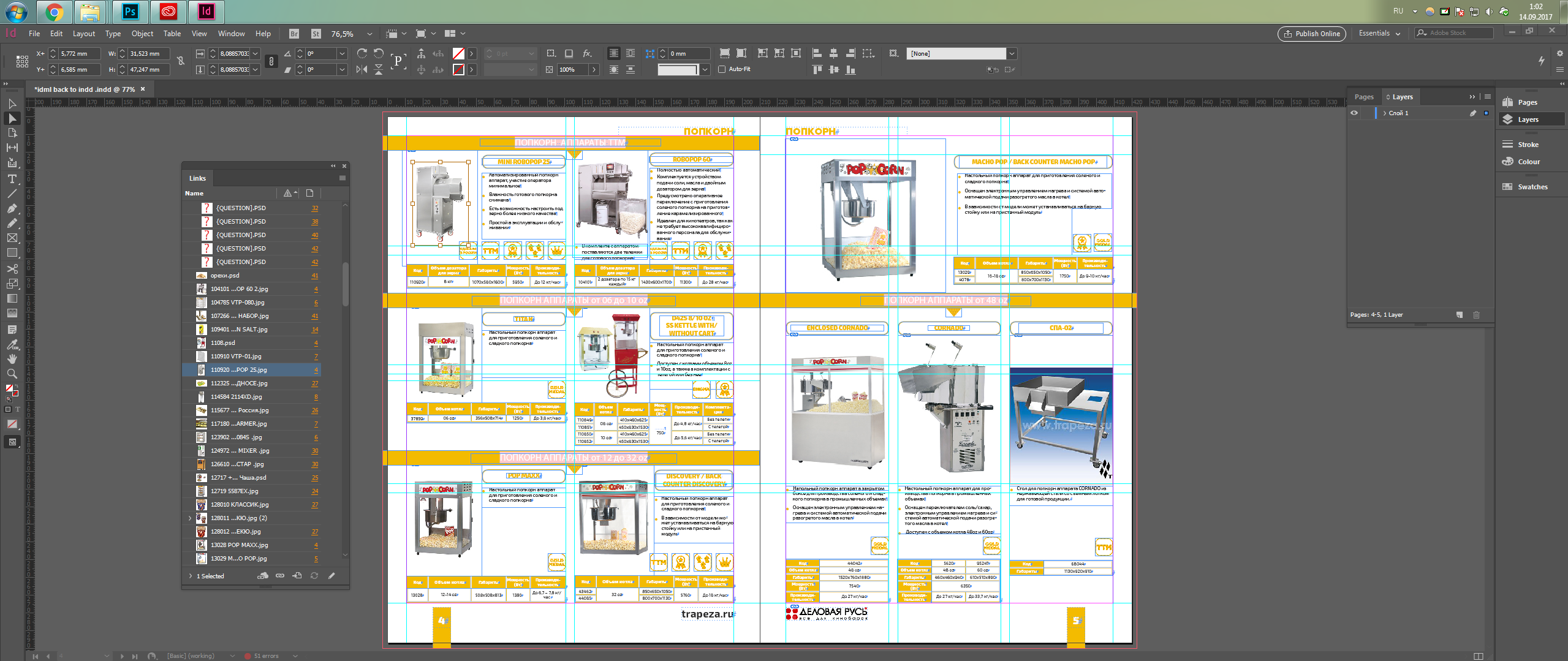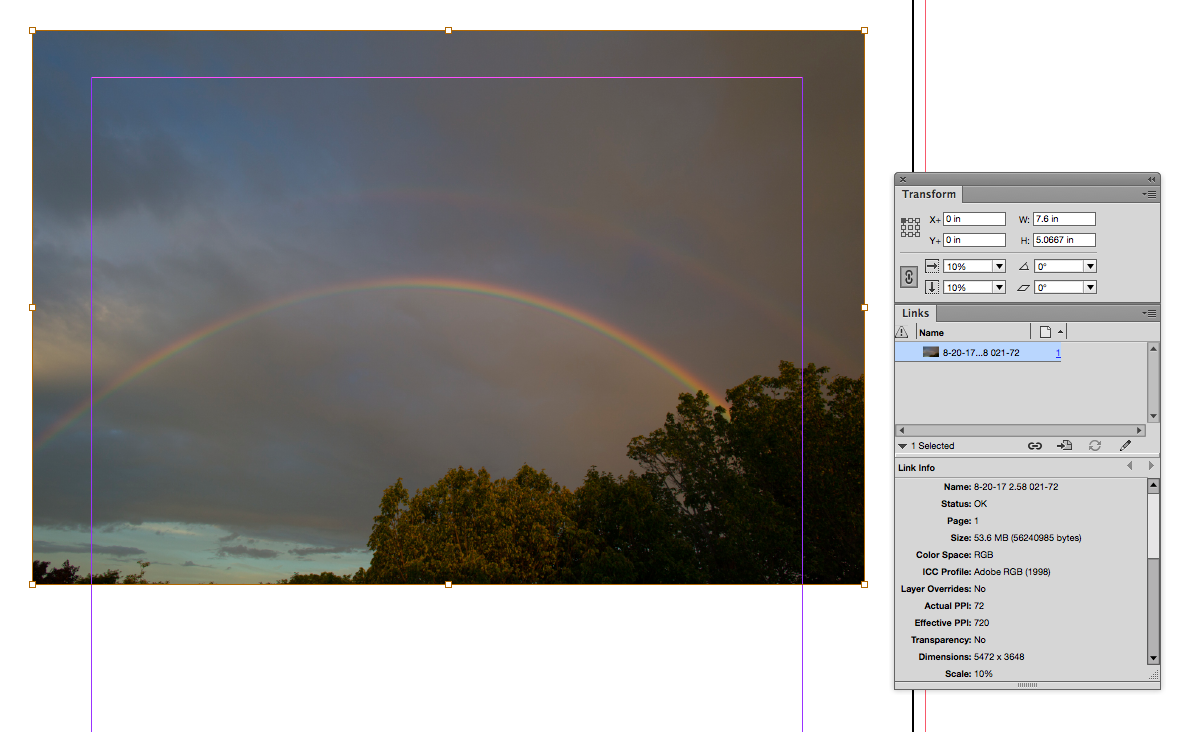Copy link to clipboard
Copied
Hello. I desperately need help. I did a pic heavy catalog(for printing, so most pics are in CMYK) in indesign which is arond 96 pages. I didnt embed any image or something, everything is linked.
So first problem is, that at some point my indesign file became 2 gigs of weight. It cant be possible.
Second problem is that, no matter how I scale down images in indesign export pdf process, exported pdf weights 2 gigs too. \
My collegue previously made similar catalog 100 pages, and it weights 100 megs. What could be wrong?
 1 Correct answer
1 Correct answer
Hm, if there would be a script which converts images to 100% effective size, I would think that's okay. But i have around 500 images, so I can't possibly convert all of them! It would take so much time and effort..
There are multiple scripts for this task, it is a common enough problem that folks have looked for a solution (this involves scripting both InDesign and Photoshop).
Copy link to clipboard
Copied
Maybe your pics are too large – what is the Effective resolution (PPI) of a typical image and what format are they in?
You should Place your images in RGB color mode and convert to CMYK by exporting to PDF (usually PDF/X-4).
Also try doing a Save As to see if that helps reduce the size.
Copy link to clipboard
Copied
Images are 300 dpi, jpeg and psd mostly. color profile is fogra39.
well, i can't place images in rgb and then convert to cmyk, because this way, i dont have any control over colors.
Copy link to clipboard
Copied
But are they in the InDesign file at 100%? If they are in at say 50% then they would have an effective resolution of 600 ppi which would make for a much larger than necessary InDesign file.
Copy link to clipboard
Copied
Exactly Bill, but I don't think the guy is listening!
Copy link to clipboard
Copied
If the files are linked there is virtually no difference in the InDesign file size.
Copy link to clipboard
Copied
Sorry, I dont understand what you mean under ''in the InDesign file at 100%''
Copy link to clipboard
Copied
When you click on an imported file with the direct selection tool check it's size in the control panel. It should say 100%. Resolution of a raster image changes as it's reduced or enlarged in size. For example if something is 300 ppi and is one inch tall it would be 300 pixels tall. If you enlarged that one inch figure to two inches one inch of it would only contain 150 pixels. What I asked earlier was what percentage of the original images were your images being brought into InDesign. So if the original was a 300 ppi image but was only being used at 50% it was now actually using 600 pixels. If you then went into Photoshop and reduced it to 50% while keeping the resolution at 300 then when it came back into InDesign it would be now reading 100% but would be using half the resolution as before. If this was the case with all of your images then by reducing them all in this manner you could possibly solve your problem.
Copy link to clipboard
Copied
 I selected it, but cant see the size percentage, can you show me via screenshot? sorry for my stupidity
I selected it, but cant see the size percentage, can you show me via screenshot? sorry for my stupidity
Copy link to clipboard
Copied
How are you handling the silhouettes? If they are clipping paths with lots of points, that could cause bloat.
When you direct select an image the Transform panel should show its scale.

Copy link to clipboard
Copied
The third field of your screenshot where there is a horizontal and a vertical arrow is showing the size that your image is coming in to be about 8%. This means that what is called the effective resolution of your images is through the roof. From my own experience I will have to disagree with Rob Day about whether resampling would do more harm than good. With an effective resolution this far off I think that it would be absolutely necessary.
Copy link to clipboard
Copied
I will have to disagree with Rob Day about whether resampling would do more harm than good. With an effective resolution this far off I think that it would be absolutely necessary.
In my #14 example I'm resizing not resampling—there's a big difference, resizing doesn't change the pixel dimensions.
If image resampling has a significant effect on the InDesign file size (10X in the OP's case) you should be able to show an example—I'm not seeing that kind of change.
Copy link to clipboard
Copied
While you may be right, Rob, that InDesign file size increases when resampling images, it has been my experience that this sizing is essential to overall efficiency and is an essential factor in proper file management. I have been working in the production studio of a large advertising agency in New York for over twenty years. It has been our experience building and releasing thousands of jobs that correct placement of images has been more important than the actual size of the InDesign file. This has been especially a factor in regard to ease of printing and for the creation of efficiently sized pdfs. We have also found that the most consistent output of images has been achieved by making sure that they have been sized to 100% with a resolution of 300 ppi (for conventional offset jobs) prior to import into InDesign. This is especially important as we are required to release jobs as the original InDesign, Photoshop and Illustrator files. Sizing images properly prior to release helps avoid later problems. You may be wondering why we don't just send pdfs. My agency is part of a global network of agencies (the second largest in the world) and it is the general practice throughout that network that the clients pick the vendors who will do the printing (and we never know who that will be). The reason for this is that it allows them to find the most cost efficient (cheapest) printer in just about any country in the world. Since that is the case files can't be prepared with proper color profiles (which vary by the country) as well as various other file requirements which change from country to country. Plus, there are often changes needed on jobs (nobody noticed a missing comma until they saw printer proofs) which need to be done at the printer because it would cost too much to send it back to the agency. Thus the need for sending the native files. So all things considered we have to make sure that the files we send out have as few loose ends, which includes properly sized images, as possible.
Copy link to clipboard
Copied
The OP's question has nothing to do with image quality. The question is why is the InDesign document file size increasing by an apparent factor of 10X:
So first problem is, that at some point my indesign file became 2 gigs of weight. It cant be possible.
If you think that only placing files at 100% where the actual and effective resolutions match has a significant affect on the ID document files size, then you should be able to demonstrate that. Given that disk space costs around a penny per GB, It would have to be and extraordinary change in file size to be worth the effort it would take to avoid scaling images in the page layout.
300ppi is a magic number—it was invented as a rule-of-thumb to set a minimum for generic image quality. Down sampling might not hurt quality, assuming the end effective resolution was high enough, but it would never improve quality.
Copy link to clipboard
Copied
I will admit, as all of us often do, to straying a bit from the original point but in looking at the OPs sizing (or lack thereof) I do still feel that even if it does not affect the InDesign file size that what I have suggested (and have thousands of jobs that will back this up) will contribute to the overall efficiency of his files going forward. I feel that I would be remiss if I did not offer this advice.
As to:
"300ppi is a magic number—it was invented as a rule-of-thumb to set a minimum for generic image quality. Down sampling might not hurt quality, assuming the end effective resolution was high enough, but it would never improve quality."
My comments about that were in regards to consistency of procedure and results over a workflow.
Copy link to clipboard
Copied
So if the original was a 300 ppi image but was only being used at 50% it was now actually using 600 pixels. If you then went into Photoshop and reduced it to 50% while keeping the resolution at 300 then when it came back into InDesign it would be now reading 100% but would be using half the resolution as before. If this was the case with all of your images then by reducing them all in this manner you could possibly solve your problem.
I do agree that scaling has some marginal affect on the document size, but I've never seen it cause anything close to a 10x change—even my extreme example where the reduction is to 10% doesn't have that much affect. In the end trying to resample files so the actual and effective resolutions match would likely cause more harm than good.
Copy link to clipboard
Copied
Generally speaking if your images are brought into InDesign at 100% size with an actual and effective resolution matching at 300 ppi you should not have a problem with either file size or reproduction. These specs are for general offset printing. A lower resolution would be possible for large posters or display panels.
Copy link to clipboard
Copied
The only way I can see a file blowing up that large is by embedding the graphics. I’d like to see a screenshot of the links panel.
I’d also suggest doing a file > save as to get rid of some of the junk in the file. Export to IDML and re-building the file when opening is another way to shrink it up.
Copy link to clipboard
Copied
Can't show you screenshot right now, but believe me, I never even used embedding. Only placing via Ctrl+D.
About IDML.. Tried it, it shrinks to something like 200 megs, then, after saving it in. idd again, it retains 2gig size..
pdf analyze says that 99 % of file weight are images, could it be, that some pictures are way too big? and so indesign embeds them full size?
Copy link to clipboard
Copied
What are your EXACT PDF export settings?
Copy link to clipboard
Copied
Hi,
Maybe Bob or others can explain this better.. but i do remember one instance when InDesign places the file in full size when it is 72ppi originally
I cant recall why it happens but opening the image in photoshop and then changing its pppi using Save as fixed the issue for me
-Aman
Copy link to clipboard
Copied
IIRC, those were images placed directly from a camera without any resolution information in them.
Copy link to clipboard
Copied
Hi,
I am confused here. How saving to .idml will also reduce the size of the exported pdf? If we are assuming the file has junk data in it, then exporting to pdf should throw away that junk? Am i wrong?
BobLevine wrote
IIRC, those were images placed directly from a camera without any resolution information in them.
Thanks Bob.
InDesign for all links creates a thumnail preview which is 72ppi. If the original file captured from the camera is also at 72ppi (even if the file size is huge) then InDesign embeds the entire image. Converting to 72 ppi in this case has no reduction on the file size. Which i guess increases InDesign file size too.
-Aman
Copy link to clipboard
Copied
I am confused here. How saving to .idml will also reduce the size of the exported pdf?
So first problem is, that at some point my indesign file became 2 gigs of weight. It cant be possible.
Second problem is that, no matter how I scale down images in indesign export pdf process, exported pdf weights 2 gigs too. \
The OP is asking about the 2GB InDesign file and the exported PDF.
InDesign for all links creates a thumnail preview which is 72ppi.
My experience is that the size of the image proxy when it is initially placed has some affect on the ID document size.
So a 20 megapixel image at 5472x3648 pixels with an actual res of 72, would place at 76"x 50" and it could be reduced by 24% to get an Effective Res of 300ppi. Even though the Effective res is high, the larger preview proxy at 76"x50" is included in the ID file size. If I resize (Resample unchecked) in Photoshop before placing, the proxy is smaller and that is reflected in a somewhat smaller ID file size.
But again it wouldn't account for the 10x change the OP is seeing.
Copy link to clipboard
Copied
About IDML.. Tried it, it shrinks to something like 200 megs, then, after saving it in. idd again, it retains 2gig size..
Rather than saving as an IDML, first try doing a simple Save As to a new ID document with a different name.
Also if the placed images are coming from a camera check the meta data in Photoshop—if there's lots of info that could add weight even when you are placing.
well, i can't place images in rgb and then convert to cmyk, because this way, i dont have any control over colors.
InDesign's CMYK conversion at export will be the same as Photoshop's assuming the source, destination, and color intents are setup the same way.
Get ready! An upgraded Adobe Community experience is coming in January.
Learn more


